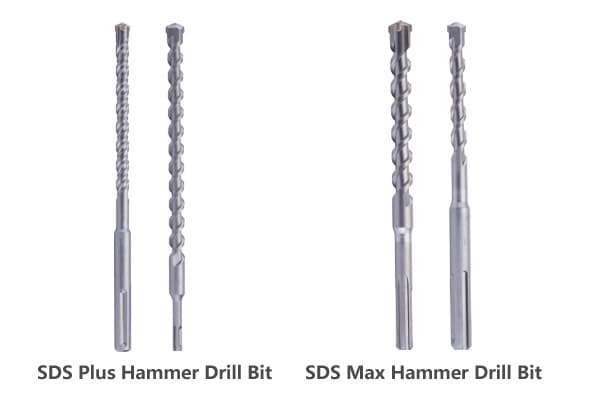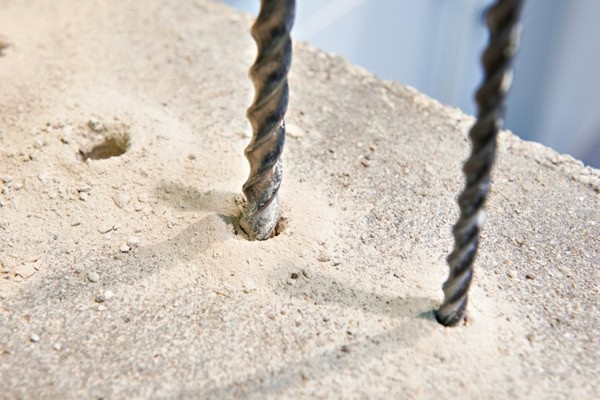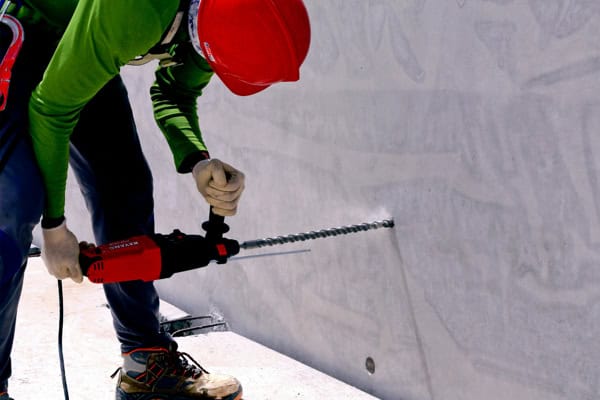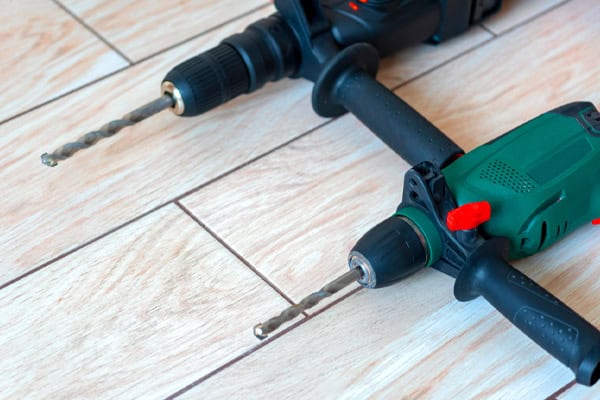Worried about tackling that tough concrete wall? You’re not alone! Many DIYers and pros wonder if they have the right tool.
A hammer drill is designed for drilling into hard materials like concrete, brick, and stone. It combines rotation with a hammering action to pulverize the material, making it easier to drill holes for anchors, fixings, or running cables.

Ready to learn more about when and how to use this powerful tool? Keep reading, and I’ll share some insights.
Can a Hammer Drill be Used on Concrete?
Ever looked at a concrete wall and wondered how to drill into it? It seems impossible, right?
Yes, a hammer drill can definitely be used on concrete! It’s designed for this purpose. The combination of rotation and hammering action allows it to effectively drill into concrete when paired with a masonry drill bit.
But how does it actually work?

Hammer vs. Regular Drill on Concrete
I remember the first time I tried drilling into concrete with a regular drill. It was a disaster! The bit just spun and spun, making no progress. That’s because a regular drill relies solely on rotation, which isn’t enough to break down hard materials like concrete.
A taladro percutor1, on the other hand, uses a pounding action in addition to rotation. Inside the drill, there’s a mechanism that creates rapid, short bursts of force, like a tiny hammer hitting the back of the drill bit. This helps to fracture the concrete2, while the rotating bit removes the debris. It’s like a mini jackhammer for your drill.
| Rasgo | taladro percutor | Regular Drill |
|---|---|---|
| Action | Rotation + Hammering | Rotation Only |
| Best for | Concrete, brick, stone | Wood, metal, plastic |
| Bit Type | Masonry bits (carbide-tipped) | Standard drill bits |
| Effectiveness | Highly effective on hard materials | Ineffective on hard materials |
| Noise Level | Louder due to hammering action | Quieter |
| Características adicionales | Stop bar to set an exact depth | N/A |
When drilling concrete, safety3 is key. Always wear eye and ear protection, work gloves, and a dust mask. Concrete dust contains silica, which can be harmful if inhaled. If you’re drilling many holes, consider using dust mask.
Is it Normal for a Hammer Drill Bit to Wobble?
Ever notice your drill bit wobbling and wonder if something’s wrong? I know I have.
A slight wobble in a hammer drill bit can be normal, especially in hammer mode. This wobble helps clear dust and debris from the hole, allowing for faster drilling in hard materials.

Diagnosing the Wobble
It’s important to distinguish between normal wobble and a sign of a problem. Here’s how I usually check:
- Check in Rotary Mode: If the bit wobbles significantly in rotary-only mode, it could be a defective bit or a problem with the drill’s chuck.
- Inspect the Bit: Look for any visible bends or damage to the drill bit. A bent bit will definitely cause a wobble.
- Tighten the Chuck: Make sure the drill bit is securely tightened in the chuck. If it’s loose, it will wobble.
- SDS Chucks: SDS (Slotted Drive System) chucks, commonly found on rotary hammers, are designed with a bit of play. This is normal and allows the bit to move freely during hammering. However, excessive wobble can still indicate an issue.
If the wobble seems excessive, try a different drill bit. If the problem persists, the drill itself might have a faulty chuck4 or internal issue. Also make sure that you’re inserting the drill bit correctly5.
| Issue | Possible Cause | Solución |
|---|---|---|
| Wobble in rotary mode | Defective bit, faulty chuck | Replace bit, repair/replace chuck |
| Bent drill bit | Impact with rebar, misuse | Replace bit |
| Loose chuck | Improper tightening | Retighten chuck securely |
| SDS chuck wobble | Normal play, excessive wear | Monitor, replace worn parts |
Remember, safety first. If you’re unsure about the wobble, it’s best to have the drill inspected by a professional.
Why Can’t I Drill into Concrete, with a Masonry Drill Bit??
Frustration hits when your drill bit just won’t bite into the concrete. I’ve been there!
If you can’t drill into concrete with a masonry bit, several factors could be at play. It could be due to using the wrong type of drill, a worn-out or low-quality drill bit, incorrect drilling technique, or encountering rebar within the concrete.
Let’s troubleshoot this.
Common Culprits
- Wrong Drill Type: A regular drill might not have enough power for concrete. Make sure you’re using a hammer drill or rotary hammer.
- Dull Drill Bit: Masonry bits can wear out quickly, especially when drilling hard concrete. Check the bit for damage or dullness.
- Incorrect Technique: Apply firm, steady pressure, but don’t force the drill. Let the hammer action do the work. Also, use lower speed to monitor dust extraction.
- Hitting Rebar: If you encounter metal, you’ve likely hit rebar. Use a rebar cutter or try a different location.
- Overheating: Concrete drilling can generate a lot of heat. Pause to let the bit cool down, or use water to keep it cool.
- Dust Extraction: Make sure the dust is being extracted continuously. If not, extract the bit, blow out the hole, and continue.
| Problem | Possible Solution |
|---|---|
| Wrong drill | Use hammer drill or rotary hammer |
| Dull bit | Replace with a sharp, high-quality masonry bit |
| Incorrect technique | Apply steady pressure, let drill do the work |
| Hitting rebar | Use rebar cutter, relocate hole |
| Calentamiento excesivo | Pause to cool bit, use water |
I recommend investing in high-quality drill bits. I use masonry bits with carbide tips, which are made with diamond particles, designed to withstand the impact of hammer drills.
What is the Best Hammer Drill to Buy?
Choosing the right hammer drill can feel overwhelming. Which one will give you the best bang for your buck?
The best hammer drill depends on your needs and budget. Factors to consider include power, size, cordless vs. corded, and features like variable speed and multiple modes. Popular brands include Milwaukee, DeWalt, Makita, and Bosch.

Here are some of my favorites:
Top Hammer Drill Recommendations
- Milwaukee M18 Fuel: This cordless hammer drill is compact, powerful, and has a long battery life.
- DeWalt 20V MAX XR: Another excellent cordless option with a brushless motor for enhanced power and runtime.
- Bosch Bulldog Xtreme: A corded rotary hammer that’s perfect for heavy-duty concrete drilling.
- Makita 18V LXT: A versatile cordless hammer drill that’s great for a variety of tasks.
When choosing a taladro percutor6, also consider the type of chuck. SDS (Slotted Drive System) chucks7 are common on rotary hammers and allow for quick and easy bit changes.
| Marca | Modelo | Escribe | Key Features |
|---|---|---|---|
| milwaukee | M18 Fuel | Cordless | Compact, powerful, long battery life |
| DeWalt | 20V MAX XR | Cordless | Brushless motor, high power and runtime |
| el bosco | Bulldog Xtreme | Corded | Heavy-duty, SDS chuck |
| makita | 18V LXT | Cordless | Versatile, good for various tasks |
Consider what features are most important to you. If you’re a professional who needs a durable and powerful tool for daily use, it’s worth investing in a higher-end model. If you’re a DIYer who only needs a hammer drill occasionally, a more affordable option might be sufficient.
Conclusión
Hammer drills are invaluable for tackling tough materials like concrete, brick, and stone. Choosing the right tool and technique is important. So get the right tool, stay safe, and get drilling!
-
Understanding the mechanics of a hammer drill can enhance your DIY skills and project efficiency. ↩
-
Learning about concrete fracturing techniques can improve your home improvement projects significantly. ↩
-
Understanding safety practices is crucial to prevent accidents and health issues while drilling concrete. Explore this link for comprehensive guidelines. ↩
-
Understanding the signs of a faulty chuck can help you troubleshoot and maintain your drill effectively. ↩
-
Learning the proper way to insert a drill bit can enhance your drilling accuracy and prevent damage. ↩
-
This resource will guide you through essential factors to consider for selecting the right hammer drill for your needs. ↩
-
Explore this link to understand the advantages of SDS chucks for efficient drilling and bit changes. ↩